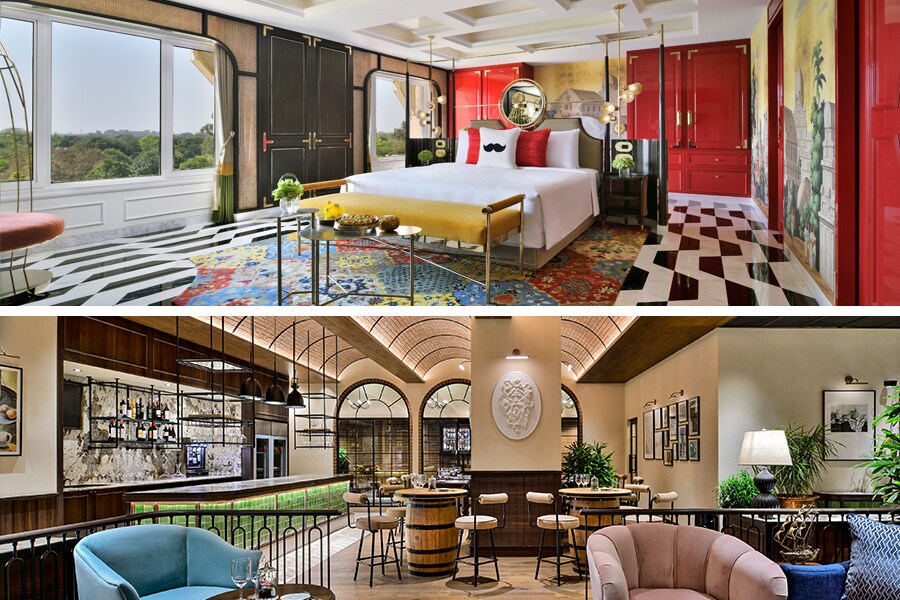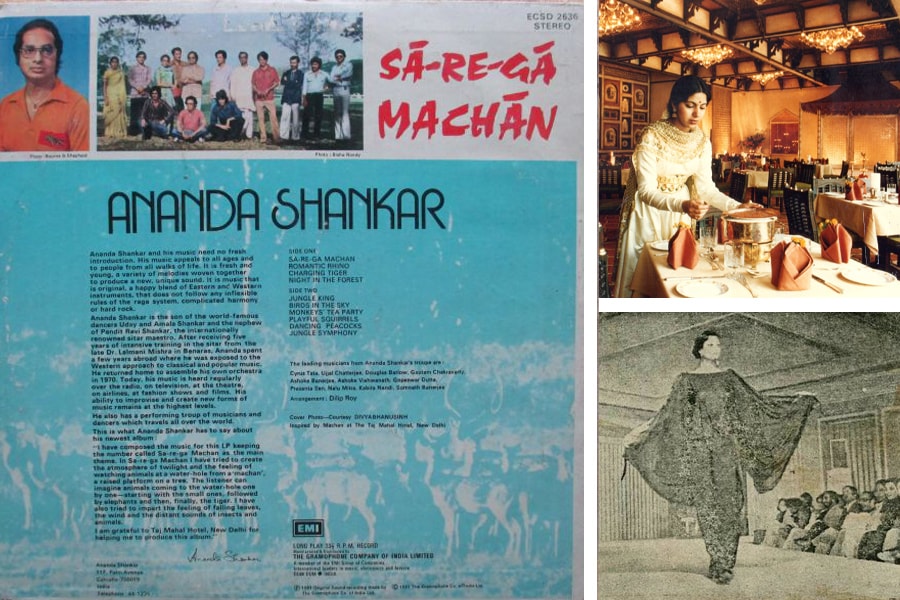
At the revamped Taj Mahal New Delhi, a younger interpretation of luxe
By Anoothi Vishal| Dec 1, 2023
Post a refurbishment that has taken around three years and over Rs 200 crore, the iconic hotel's restaurants, rooms and the coveted private members club Chambers have all been 'reimagined' to fit new definitions of luxury for the Gen Z and millennial affluent
 [CAPTION]Master bedroom of The Maharaja Suite (above) and Captain's Cellar, the wine bar at the newly refurbished Taj Mahal hotel on Mansingh Road in New Delhi.[/CAPTION]
[CAPTION]Master bedroom of The Maharaja Suite (above) and Captain's Cellar, the wine bar at the newly refurbished Taj Mahal hotel on Mansingh Road in New Delhi.[/CAPTION]
When the Taj Mahal New Delhi opened on an autumnal Dussehra day in 1978, ‘New Delhi’ was as yet a sluggish town of new money; a political capital but not yet the cultural, social, gastronomic capital of today. The Emergency was just over, a Morarji Desai-led Janta government was in power, and Coca Cola had just quit the Indian market after a change in policy.
It was against this backdrop that the new Taj at 1 Mansingh Road (it would be dubbed ‘Taj Mansingh’ in perpetuity) — just the second hotel to be opened by the Tatas, after the Gateway of India icon they built in 1903 — decided to bring in a dash of sartorial style and glamour. A Yves Saint Laurent fashion show kicked off its events calendar, highly unusual for the times. ‘Lifestyle’ had met Delhi. The rest, as they say, is history.
_RSS_It’s been 45 years for one of Delhi’s—and India’s—most iconic hotels. But the Taj Mahal New Delhi is not doddering into its middle years. Instead, it is relaunching this weekend with a bang—post a refurbishment that has taken around 3 years and over Rs 200 crore.
Its legendary restaurants, rooms and the coveted private members club Chambers have all been “reimagined” to fit new definitions of luxury for the Gen Z and millennial affluent; the start-up mavericks, creative entrepreneurs and new movers and shakers that make up ‘society’ now.
But there’s dollops of nostalgia nevertheless: The story of the hotel is entwined with the story of India’s capital.
Since that YSL show in 1978, the hotel has been both a witness to and instrumental in changing the tastes and culture of subsequent generations, changes that gained momentum in the late 1990s and early 2000s as India’s post liberalisation generations started consuming luxe.
From Delhi's first 24-hour ‘coffee shop’, the much-loved Machan, haunt of an entire generation of late-night revellers who’d seek sustenance off its post-midnight menu priced cheaper than the rest, or drop in to indulge in the famous Bull’s Eye, part cake, part ice cream (a chief sub at my first newspaper would treat us to this after tough night shifts, before BPOs made late-night binges par for the course) to Rick’s, India’s first cocktail bar that opened in 2002, and doubled up as a ‘living room’ for the city’s affluent, where cricketers, industrialists, artists and other famous last names converged over Bloody Marys with quaint lemongrass swizzle sticks, deemed a novelty then, to the House of Ming, the first Chinese restaurant in a hotel, whose golden fried prawns were ostensibly a favourite with then Prime Minister Atal Bihari Vajpayee (and are still on the menu, even as the restaurant has shed its Indian-Chinese image and glammed up), and more. Almost every well-to-do Dilliwallah has stories about ‘life moments’ that played out here.
Also read: How Taj Hotels is revamping its age-old business model
This includes Puneet Chhatwal, MD and CEO, Indian Hotels Company Limited (IHCL), which runs the Taj hotels and sister brands. “It’s one of the reasons I became a hotelier,” he told me some time ago when we spoke about Machan. As a young hospitality student at IHM Pusa Road (where he was a classmate of India’s first TV celebrity chef Sanjeev Kapoor), Chhatwal says he spent many evenings at Machan sitting for hours over a single cup of coffee. It was all he could afford as a student. But he liked watching diners come and go. It proved to be an inspiration and a learning in hospitality.
Under Chhatwal, who took over the reins of IHCL in 2017, the Taj group of hotels and its sister brands is restructuring, expanding its luxury portfolio aggressively, and “reimagining” its past.
It’s a strategy to turn the business more profitable by upping luxury and higher margin product offerings, including food experiences. “At the heart of our strategy lie iconic assets such as the Taj Mahal New Delhi that are setting benchmarks in the luxury space... As we evolve, we ensure that our legacy and contemporary offerings blend seamlessly,” says Chhatwal, who talks about how the old iconic hotels are pivoting to enable “us to introduce high-margin products and services… this approach is about strategically repositioning our assets to maximise profitability on every square foot and offering unparalleled experiences to our valued patrons”.
So how has the old Taj in Delhi pivoted to current tastes and trends? For one, the legacy restaurants that had been shut for their makeover (not just cosmetic, but complete new contemporarised menus, service and look) are back in stylish new versions.
But if hotels are about rooms, the spanking new luxury suites too are geared up to a younger consumer—with a nod to legacy. A Maharaja suite, for instance, pays homage to the historic Air India icon with the trademark moustache built into visual aesthetics but the design and features are contemporary and chic.  [CAPTION](from left), Ananda Shankar's album, which the Taj helped produce, is a nod to Machan, Delhi's first 24 hour coffee shop. Haveli, the indian restaurant which became Varq. An Yves Saint Laurent fashion show kicked off the new hotel's calendar in 1978. [/CAPTION]
[CAPTION](from left), Ananda Shankar's album, which the Taj helped produce, is a nod to Machan, Delhi's first 24 hour coffee shop. Haveli, the indian restaurant which became Varq. An Yves Saint Laurent fashion show kicked off the new hotel's calendar in 1978. [/CAPTION]
At Chambers, the exclusive private members club that is now seeking a younger and more global membership profile, exclusivity is not stiff. The club is sprawled across two floors with stunning views of the Rashtrapati Bhavan, a priceless RK Laxman collection adorns the walls to the entrance, and you could sit in a Stephano Ricci-designed meeting room, and eat off Bernardaud dinnerware. But what most younger members at this elite club seem to be doing is using the cocktail lounge to conduct informal meetings over gin tastings and sometimes off-the-menu food created as per their preferences. “There are fresh salads, and everything is lighter, sourced ethically and not too spiced,” executive chef Arun Sundararaj points out, given the accent on wellness. A not-so-known perk is also creating your own cocktail, getting a number for it on a plaque, and then being able to order that drink at all times subsequently—prestige drinking can’t get more bespoke.
The old Rick’s where I had once lounged along with the early-2000s ‘society’ has re-emerged too. Instead of the Prohibition era classic cocktails that were new to India at the turn of the millennium, super sophisticated technique-led drinks (milk washes, sous vide, clarifications, miso-infused, serious ice programme) announce the shift to a generation that may or may not know Casablanca.
Also read: Hospitality industry demonstrated character during the pandemic: Puneet Chhatwal
But it is with Captain’s Cellar, the most ambitious wine bar in India at the moment, that the Taj Mahal New Delhi is breaking new ground. In a country where wine has never become part of the pop culture—even as gin, whisky and now tequila trends come and go—this is a brave move making wine more accessible and fun, breaking old stuffy stereotypes. There are 164 labels available, 42 wines by the glass and 20 on the Enomatic, a serving system that has been available in India for about two decades but used infrequently and mostly back of the house (opened bottles can remain unoxidised, promoting by the glass serves). At this new bar, the machine becomes a showcase, a contraption to make reels of, and try different varietals and different styles from.
This is luxury removed from old world snobbery, though if you were able to pick out the trick to the perfect Basque cheesecake that Sundararaj and his team achieve in their menu of Spanish tapas (a chef was sent to Spain to train) that will mark you out as a true connoisseur. “The cheesecake was a project I was following up for many days, the first one was eggy, then we reworked the cooking and cooling time, and then the boys told me that the trick was also blue cheese. We add a small piece of Danish Blue that just sits there,” says Sundararaj with a grin.
In an older metropolis, the front row invite to a fashion show may have been the ultimate signifier of prestige but now, it is passion—of a foodie delving deep into his dessert!